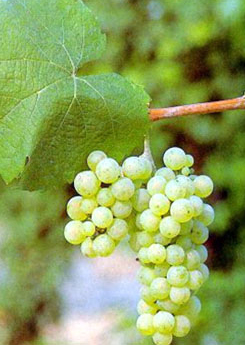 |
Riesling Riesling is a white grape variety which originates in the Rhine region of Germany. Riesling is an aromatic grape variety displaying flowery, almost perfumed, aromas as well as high acidity. It is used to make dry, semi-sweet, sweet and sparkling white wines. Riesling wines are usually varietally pure and are seldom oaked. As of 2004, Riesling was estimated to be the world's 20th most grown variety at 48,700 hectares (120,000 acres) (with an increasing trend),but in terms of importance for quality wines, it is usually included in the "top three" white wine varieties together with Chardonnay and Sauvignon Blanc. Riesling is a variety which is highly "terroir-expressive", meaning that the character of Riesling wines is clearly influenced by the wine's place of origin. Riesling wines are often consumed when young, when they make a fruity and aromatic wine which may have aromas of green or other apples, grapefruit, peach, honey, rose blossom or cut green grass, and usually a crisp taste due to the high acidity.However, Riesling's naturally high acidity and range of flavours make it suitable for extended aging. In wine making, the delicate nature of the Riesling grape requires special handling during harvesting to avoid crushing or bruising the skin. Without this care, the broken skins could leak tannin into the juice, giving a markedly coarse taste and throwing off balance the Riesling’s range of flavors and aromas. Riesling is a versatile wine for pairing with food, because of its balance of sugar and acidity. It can be paired with white fish or pork, and is one of the few wines that can stand up to the stronger flavours and spices of Thai and Chinese cuisine.A Riesling's typical aromas are of flowers, tropical fruits, and mineral stone (such as slate or quartz), although, with time, the wine acquires a petrol note as mentioned above. Riesling is almost never fermented or aged in new oak (although large old oak barrels are often used to store and stabilize Riesling based wines in Germany and Alsace).This means that Riesling tends to be lighter weight and therefore suitable to a wider range of foods. The sharp acidity/sweetness in Rieslings can serve as a good balance to foods that have a high salt content. In Germany, cabbage is sometimes cooked with riesling to reduce the vegetable's smell Rieslings have a large variety of styles ranging from bone dry to rich desert type flavours. It pairs with all kinds of food really well. I was originated in Germany and the best Riesling in the world is found in Germany. It is a light and crisp white wine. It is sweet but not always. Some Riesling’s have residual sugar left after fermentation. Its aromas are bold and very prominent. A fragrant whiff of green apple can be found. Pear and honey may also be found. Sometimes, slate, flint or mineral smell can be found as it is grown in slatey soil. Its taste or flavours are powerful. It has a high acidity and we can find the mouth salivating after a sip. And it goes will with highly spiced foods. |
|
||||||||||

